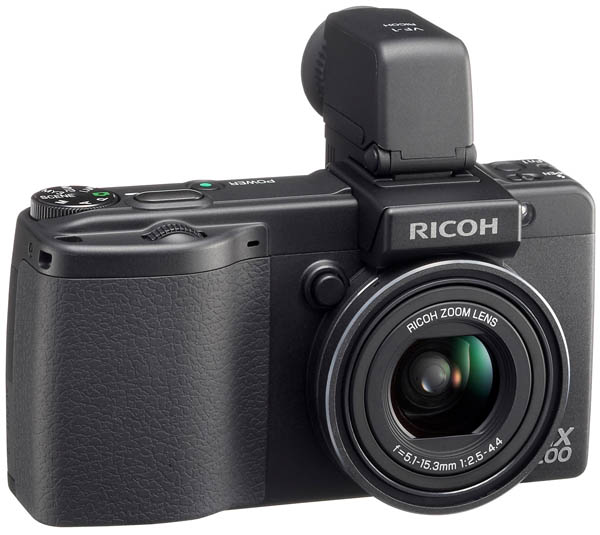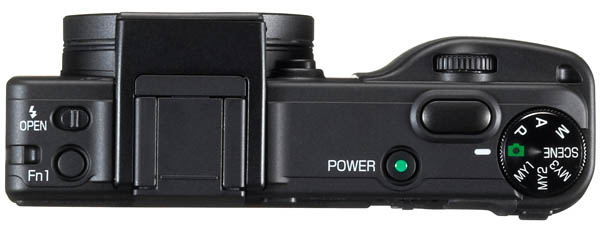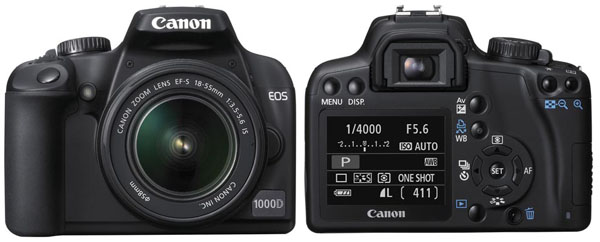Nikon has officially announced the Nikon D700, a compact, professional, full frame (FX format) digital SLR. The D700 features the same 36x24mm, full frame, 12.1 megapixel CMOS sensor as the more expensive D3 model, and the D700 also offers and extensive ISO range of ISO 200 – 6400: extendable up to 25600 (equivalent) and down to ISO 100 (equivalent).
The Nikon D700 also features 5fps continuous shooting (8fps with optional MB-D10 battery pack), EXPEED image processing engine with 14-bit A/D conversion and 16-bit image processing for superb detail and tonal gradation, 51-point AF system, Live View function, 920,000 dot 3-inch VGA LCD monitor with wide, 170-degree viewing angle, HDMI video output and Active D-Lighting. The D700 also includes several function improvements over the D3 including Image Sensor cleaning (‘sensor shake’), more flexible ‘hard button’ programming, virtual horizon in Live View and different DX mode indication on the focusing screen. The D700 also becomes the first professional Nikon DSLR to sport a built-in flash.
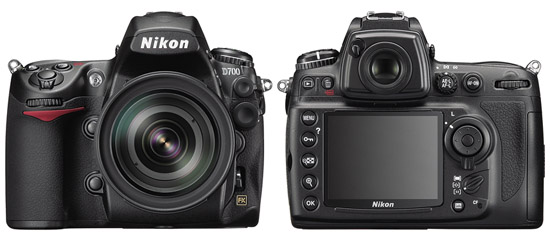
The Nikon D700 is available for pre-order from Amazon: (follow links below for info and price)
Nikon D700 12.1MP Digital SLR Camera (Body Only)
Nikon D700 12.1MP Digital SLR Camera with 24-120mm f/3.5-5.6G ED IF VR Nikkor Zoom Lens
Nikon D700 Key Features
- 12.1 megapixel FX (full-frame) CMOS sensor with high signal-to-noise ratio, wide dynamic range, and built-in self-cleaning sensor unit that minimizes dust.
- ISO 200 – 6400: extendable up to 25600 (equivalent) and down to ISO 100 (equivalent).
- 5fps continuous shooting (8fps with optional MB-D10 battery pack with lithium-ion battery EN-EL4a or 8 AA batteries).
- EXPEED image processing engine with 14-bit A/D conversion and 16-bit image processing for superb detail and tonal gradation.
- Advanced Scene Recognition System combines the camera’s metering and AF sensors for precise exposures and sharply defined images.
- Multi-CAM3500FX 51-point AF system. Individually selectable or configurable in 9-point, 21-point and 51-point coverage settings.
- Picture Controls streamline in-camera image processing by enabling the pre-set customization of image parameters such as sharpening, contrast, brightness, hue and saturation in various color modes.
- 920,000 dot 3-inch VGA LCD monitor with wide, 170-degree viewing angle.
- Live View with Autofocus enables composition of images by use of the LCD monitor. Two modes are supported: Handheld or Tripod.
- DX Crop Mode can be automatically enabled when a DX format lens is attached.
- Quick response: approx. 40 ms shutter-lag.
- Active D-Lighting enables superior high-contrast images by automatically applying tone compensation at the moment of capture.
- HDMI video output interface enables connection to high-definition video systems.
- Intuitive ergonomics with optimized button placement for fast and comfortable handling.
- Durable Magnesium alloy body: moisture and dust resistant.
- Wireless LAN and Ethernet support via optional Wireless Transmitter WT-4.
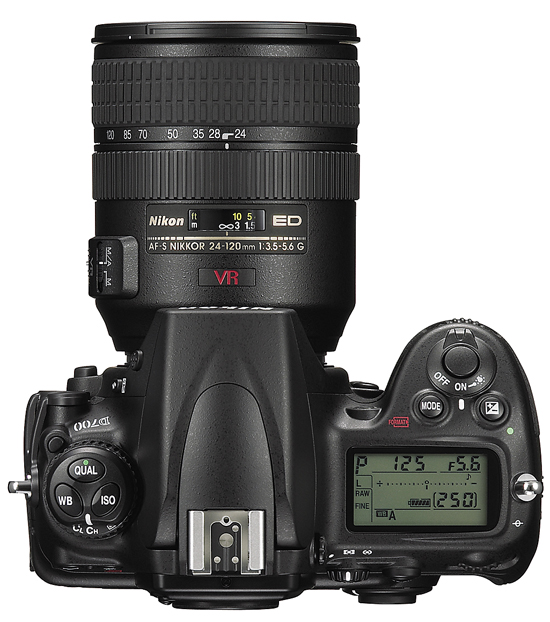
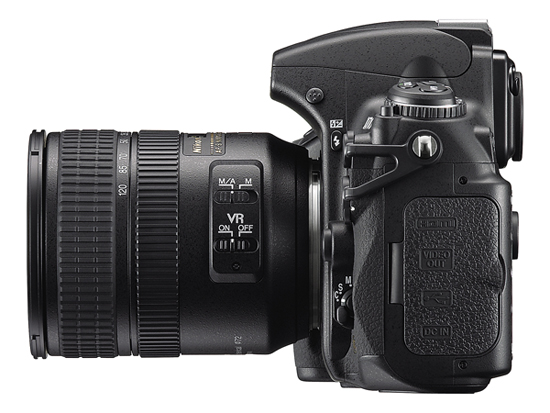
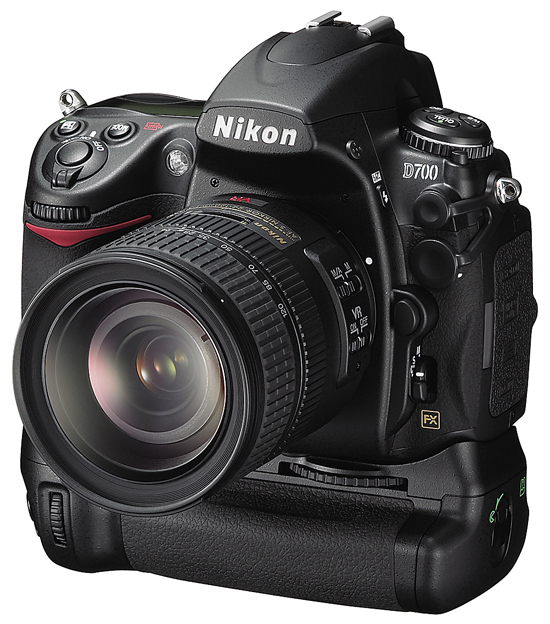
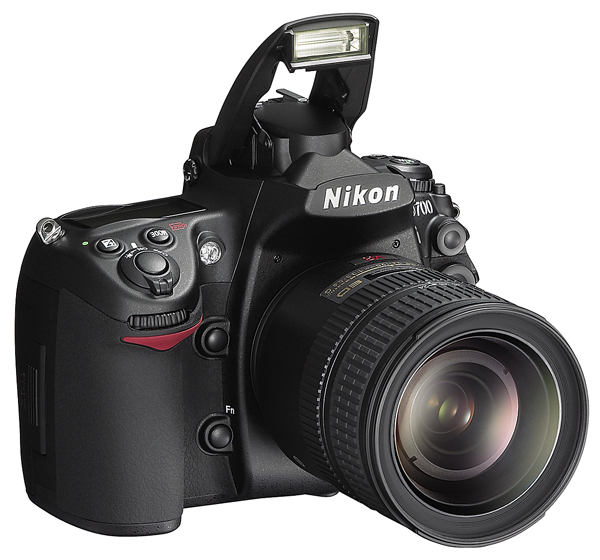
Get a price on the Nikon D700 and pre-order from Amazon: (they will be in high demand so order quickly)
Nikon D700 12.1MP Digital SLR Camera (Body Only)
Nikon D700 12.1MP Digital SLR Camera with 24-120mm f/3.5-5.6G ED IF VR Nikkor Zoom Lens
Nikon D700 Press Release
Nikon FX-format digital SLR – exceptional performance combined with superior mobility and functional versatility to provide serious photographers with outstanding value
TOKYO – Nikon Corporation is pleased to announce the introduction of its newest FX-format digital SLR, the Nikon D700.
The D700 features an FX-format first introduced with the Nikon D3. Highly praised for its outstanding features, the D3 established a new level of professional performance in terms of overall image quality, extraordinarily low noise, ISO sensitivity range, continuous high-speed shooting, color gradation, image crispness, durability, weather-resistant operation, system versatility and more.
The new D700 incorporates an extensive array of features that boast a level of performance that is in many ways comparable to the D3. At the same time, it derives a wide range of benefits – including functionality, flexibility and operability – from the more agile D300, Nikon’s flagship DX-format D-SLR.
The D700 has everything it takes to satisfy a broad spectrum of photographic needs. The 12.1-megapixel FX-format CMOS sensor with a sensing area of 36.0 x 23.9 mm; a sensitivity range of ISO 200 to 6400; continuous shooting at up to 5 frames per second (and up to 8 fps with the optional Multi-Power Battery Pack MB-D10; Nikon’s exclusive 51-point AF system; Scene Recognition System for optimum autofocus, auto exposure and auto white balance detection – these are but a few of the advanced capabilities of the extraordinary new D700.
Major Features
Large image sensor, developed by Nikon; 12.1 effective megapixels
The D700 employs an FX-format CMOS image sensor with an area of 36.0mm (h) x 23.9mm (v). It provides superior picture quality throughout a wide ISO sensitivity range, with advantages that include a large pixel size to ensure a higher signal-to-noise ratio and wide dynamic range, and improved circuit layout to efficiently increase the strength of the electrical signal from pixels. High-speed, 12-channel readout enables fast continuous shooting of high-resolution images at up to 8 frames per second (with Multi-Power Battery Pack MB-D10 and Rechargeable Li-ion Battery EN-EL4a/4 or eight AA-size batteries).
Wide sensitivity range
The D700 offers an extremely wide sensitivity range of ISO 200 to 6400. It delivers extraordinary image quality at low sensitivity settings, while also delivering outstandingly low-noise characteristics at ISO settings as high as 6400. Furthermore, sensitivity can be increased to HI 0.3, HI 0.5, HI 0.7, HI 1 (ISO 12,800 equivalent), HI 2 (ISO 25,600 equivalent), or decreased to Lo 1 (ISO 100 equivalent), Lo 0.7, Lo 0.5 and Lo 0.3, to expand shooting versatility.
High-speed performance
Features a startup time of approximately 0.12 second, and a shutter release time lag of only 40 ms* – both equivalent to the flagship Nikon D3. The continuous shooting speed is up to 5 frames per second with the included Rechargeable Li-ion Battery EN-EL3e, and up to 8 fps when using the optional Multi-Power Battery Pack MB-D10 and Rechargeable Li-ion Battery EN-EL4a/4 or eight AA-size batteries. The Nikon D700 is also compliant with the next-generation high-speed UDMA CompactFlash cards, that will enable 35-Mbyte recording speed.
* Based on the new CIPA guideline established in August 2007.
EXPEED image processing
Nikon’s state-of-the-art EXPEED digital image-processing incorporates remarkable intelligence and technologies accumulated and optimized throughout our long history. It makes possible a diverse range of functions that ensure superior picture quality and high-speed image processing.
Scene Recognition System
Improvements to the exclusive 1,005-pixel RGB light sensor have allowed information from the sensor to be utilized for auto exposure, auto white balance and autofocus. 3D-Tracking in AF, for example, achieved by using the Scene Recognition System, tracks subject position and automatically shifts the AF points used to match the subject’s movement within the frame. This system also contributes to higher accuracy of auto exposure and auto white balance detection.
Picture Control System
Nikon’s Control System enables users, from novices to professionals, to create the pictures they envision by making specific selections and adjustments to image sharpening, tone compensation, brightness, tone and saturation. Even with different cameras, when the settings are the same, you get the same picture tone. Picture Control System offers four fundamental setting options – Standard, Neutral, Vivid and Monochrome – for easy customization of image parameters.
Active D-Lighting lets photographers choose from various intensities – Auto, High, Normal, Low or OFF (Unchanged) – prior to shooting. Instead of employing the conventional compensation method of simply expanding dynamic range, localized tone control technology is utilized to ensure proper contrast and eliminate flat images with lost highlights and shadows.
AF system with high-density 51-point AF
The D700 incorporates a Multi-CAM 3500FX autofocus sensor module featuring 51 AF points. Fifteen cross-type sensors located in the center enable subject detection with lens apertures as small as f/5.6. The functioning of the AF points is linked to the Scene Recognition System, to deliver superior subject detection and focus tracking performance. A single AF point can be selected from the 51 or 11 focus points. In Dynamic-area AF mode, you can select from either 9, 21 or 51 AF areas. The 51-point option offers 3D-Tracking mode, which automatically shifts the focus point to match the subject’s movements. Auto-area AF mode gives greater priority to the subject’s position when selecting AF points.
Choose from two Live View modes
Live View allows shooting while confirming the subject on the 3-inch, 920,000-dot color LCD monitor. In Handheld mode, which lets you recompose the frame prior to actual shooting, ordinary TTL phase-detection AF is activated, using all 51 AF points including 15 cross-type points. Tripod mode is designed for precise focus accuracy with still subjects and tripod stabilization. It enables focal-plane contrast-detect AF on a desired point within a specific area. Remote view, focusing and shooting can also be controlled from a PC (via connection or wireless) using optional Nikon Camera Control Pro 2 software.
The Nikon D700 lets you select from either FX format (36 x 24) or DX format (24 x 16). At the default setting of [Auto DX crop], the camera will automatically select DX format when a DX NIKKOR lens is attached.
High-definition, 3-inch VGA, TFT LCD monitor with wide viewing angle
The ultrahigh-definition [920,000-dot VGA (640 x 480)], 3-inch LCD monitor with tempered glass provides a 170° viewing angle. The large monitor is remarkably effective when confirming the focus with enlarged playback images. The wide viewing angle enables easy recomposing of the frame in Hand-held mode with Live View.
Viewfinder provides 95% frame coverage, 0.72x magnification in FX format
The viewfinder features an eye-level pentaprism with high refraction index and provides 95% frame coverage with 0.72x magnification. Fifty-one AF points and a framing grid are superimposed on the finder screen. The eyepoint is 18 mm (at –0.1 m-1), and the diopter can be adjusted within a range of –3 to +1 m-1.
Vibrations at four different resonant frequencies remove dust from the optical low-pass filter in front of the image sensor. This function is automatically activated each time the camera is turned on and off, and can also be activated on demand by the photographer.
Built-in flash with wireless commander function
With a guide number of approximately 17/56 (m/ft., ISO 200, 20°C/68°F) and 24mm lens coverage, the high-performance built-in flash enables i-TTL flash control that evaluates flash exposure with greater precision for exceptional results. Compatible with the Nikon Creative Lighting System, the built-in flash controls up to two groups of remote units as a master/commander in Advanced Wireless Lighting.
A magnesium alloy is used for the exterior cover, rear body and mirror box to reduce weight and provide rugged durability. O-ring sealing where connections are made gives you valuable protection against dust and moisture. The shutter unit developed and manufactured by Nikon employs shutter blades made of a new material (a hybrid of carbon fiber and Kevlar). Tested on fully assembled cameras, the D700’s shutter unit has been proven through 150,000 cycles under demanding conditions. The self-diagnostic shutter constantly monitors and maintains shutter precision.
The optional Multi-Power Battery Pack MB-D10, which uses one Rechargeable Li-ion Battery EN-EL4a/4/3e or eight AA-size batteries, is equipped with a shutter-release button, AF-ON button, multi selector, and main- and sub-command dials. When attached, it enables high-speed continuous shooting of 12.1-megapixel images at a rate of up to 8 fps*. * When using EN-EL4a/4 or eight AA-size batteries.
Exclusive Wireless Transmitter WT-4/4A (option)
The WT-4/4A supports both wired LAN (10BASE-T, 100BASE-TX) and wireless LAN (IEEE 802.11b/g, 11a), and incorporates a thumbnail mode. A PC allows wireless connection of up to five cameras, for display of thumbnail images and downloading of selected images. Using Camera Control Pro 2 (option) and the Live View function, wireless remote view/control shooting is also possible.
The focal point in AF for the current CPU lenses can be fine-tuned and registered. A certain level of adjustment set for up to 12 lens types is applied when a lens of the same type is attached. When using a lens that has not been registered, the same level of adjustment can be applied.
Improved Function button feature
In addition to the exclusive Function button, this feature can be assigned to the Preview button and the AE/AF Lock button, for optimum flexibility. Furthermore, NEF copy recording together with JPEG image can be assigned to the Function button.
HDMI output (High-Definition TV) supported
The D700 complies with HDMI (High-Definition Multimedia Interface) Ver. 1.3a for the transfer of global-standard video and audio signals. A Type C mini connector is provided.
Various shooting information is displayed on the LCD monitor, including shutter speed and aperture. Character color can be adjusted to match lighting conditions – black for light locations, white for dark locations. Auto switch mode can also be set.
A variety of setting options can be customized under My Menu, then added to, deleted and reordered.
Electronic Virtual Horizon
Using a sensor incorporated in the body, the inclination of the camera is detected and displayed in the LCD monitor.
ViewNX/Nikon Transfer image-management software included in Software Suite CD-ROM
The ViewNX viewer application offers quick display of images; Nikon Transfer enables simple transfer of taken images to a computer.
Nikon Digital SLR Camera D700 Specifications
|
Type
|
Single-lens reflex digital camera
|
|
Lens Mount
|
Nikon F bayonet mount with AF coupling and AF contacts
|
|
Picture Angle
|
Equivalent to angle produced by lens focal length |
|
Effective Pixels
|
12.1 million
|
|
Image Sensor
|
CMOS sensor, 36.0 x 23.9 mm; Nikon FX format
|
|
Total Pixels
|
12.87 million
|
|
Dust-Reduction System
|
Image sensor self-cleaning function, Image Dust Off reference data acquisition (Capture NX 2 required) |
|
Image size (pixels)
|
FX format (36 x 24): 4,256 x 2,832 [L], 3,184 x 2,120 [M], 2,128 x 1,416 [S] |
|
File Format
|
• NEF (RAW): 12 or 14 bit, lossless compressed, compressed, or uncompressed |
|
Picture Control System
|
Four setting options: Standard, Neutral, Vivid, Monochrome; each option can be adjusted |
|
Storage Media
|
CompactFlash (Type I, compliant with UDMA)
|
|
File System
|
Compliant with DCF 2.0, DPOF, Exif 2.21, Pictbridge
|
|
Viewfinder
|
SLR-type with fixed eye-level pentaprism
|
|
Diopter Adjustment
|
-3 to +1 m-1
|
|
Eyepoint
|
18 mm (-1.0 m-1)
|
|
Focusing Screen
|
Type B BriteView Clear Matte VI screen with superimposed AF points and framing grid lines |
|
Frame Coverage
|
Approx. 95% (vertical/horizontal)
|
|
Magnification
|
Approx. 0.72x (50mm f/1.4 lens at infinity; -1.0 m-1)
|
|
Reflex Mirror
|
Quick-return type
|
|
Depth-of-field Preview
|
When CPU lens is attached, lens aperture can be stopped down to value selected by user (A and M modes) or value selected by camera (P and S modes) |
|
Lens Aperture
|
Instant-return type, with depth-of-field preview button
|
|
Compatible Lenses
|
• DX AF Nikkor: All functions supported |
|
Shutter Type
|
Electronically controlled vertical-travel focal-plane shutter |
|
Shutter Speed
|
1/8,000 to 30 s in steps of 1/3, 1/2 or 1 EV, Bulb, X250
|
|
Flash Sync Speed
|
X = 1/250 s; synchronizes with shutter at 1/320 s or slower (flash range drops at speeds between 1/250 and 1/320 s) |
|
Release Modes
|
1) Single-frame [S] mode |
|
Continuous Shooting Speed
|
With Rechargeable Li-ion Battery EN-EL3e: 1-5 frames per second in [CL] mode, 5 fps in [CH] mode |
|
Self-timer
|
Electronically controlled timer with duration of 2, 5, 10 or 20 s |
|
Metering
|
TTL full-aperture exposure metering using 1,005-pixel RGB sensor |
|
Metering System
|
1) 3D Color Matrix Metering II (type G and D lenses); Color Matrix Metering II (other CPU lenses); Color Matrix Metering (non-CPU lenses if user provides lens data) |
|
Metering Range
|
1) 0 to 20 EV (Matrix or Center-Weighted Metering) |
|
Exposure Meter Coupling
|
Combined CPU and AI
|
|
Exposure Modes
|
1) Programmed Auto (P) with flexible program |
|
Exposure Compensation
|
±5 EV in increments of 1/3, 1/2 or 1 EV
|
|
Exposure Lock
|
Exposure locked at detected value with AE-L/AF-L button
|
|
Exposure Bracketing
|
Exposure and/or flash bracketing (2 to 9 exposures in increments of 1/3, 1/2, 2/3 or 1 EV) |
|
Sensitivity
|
ISO 200 to 6400 in steps of 1/3, 1/2, or 1 EV; can be set to approx. 0.3, 0.5, 0.7, or 1 (ISO 100 equivalent) EV below ISO 200, or to approx. 0.3, 0.5, 0.7, 1 (ISO 12800 equivalent), or 2 (ISO 25600 equivalent) EV over ISO 6400 |
|
Active D-Lighting
|
Can be selected from [Auto], [High], [Normal], or [Low]
|
|
Autofocus
|
TTL phase-detection AF, 51 focus points (15 cross-sensors) by Nikon Multi-CAM 3500FX autofocus module; Detection: -1 to +19 EV (ISO 100 at 20°C/68°F); AF fine tuning possible; AF-assist illuminator (range approx. 0.5-3 m/1.6-9.8 ft.) |
|
Lens Servo
|
1) Autofocus: Single-servo AF (S); Continuous-servo AF (C); Focus Tracking automatically activated according to subject status |
|
Focus Point
|
Single AF point can be selected from 51 or 11 focus points
|
|
AF-Area Mode
|
1) Single-point AF |
|
Built-in Flash
|
Manual pop-up type; guide number of 17/56 (ISO 200, m/ft., 20°C/68°F) or 12/39 (ISO 100, m/ft., 20°C/68°F) |
|
Flash Control
|
1) TTL flash control with 1,005-pixel RGB sensor; i-TTL balanced fill-flash and standard i-TTL fill-flash available with SB-900, 800, 600 or 400 |
|
Flash Sync Modes
|
1) Front-curtain sync (normal) |
|
Flash Compensation
|
-3 to +1 EV in increments of 1/3, 1/2 or 1 EV
|
|
Flash-ready Indicator
|
Lights when Speedlight such as SB-900, SB-800, SB-600, SB-400, SB-80DX, SB-28DX, or SB-50DX is fully charged; blinks after flash is fired at full output |
|
Accessory Shoe
|
Standard ISO 518 hot-shoe contact with safety lock
|
|
Sync Terminal
|
ISO 519 standard terminal
|
|
Nikon Creative Lighting System
|
With Speedlights such as SB-900, SB-800, SB-600, SB-R200, or SU-800 (commander only), supports Advanced Wireless Lighting, Auto FP High-Speed Sync, Flash Color Information Communication, modeling flash and FV lock; built-in flash can be used as a commander |
|
White Balance
|
• Auto (TTL white balance with main image sensor and 1,005-pixel RGB sensor); |
|
Live View Modes
|
Hand-held mode: TTL phase-detection AF with 51 focus areas (15 cross-type sensors) Tripod mode: Contrast-detect AF on a desired point within a specific area |
|
LCD Monitor
|
3-in., approx. 920,000-dot (VGA), 170-degree wide-viewing-angle, 100% frame coverage, low-temperature polysilicon TFT LCD with brightness adjustment |
|
Playback Function
|
Full-frame and thumbnail (4 or 9 images) playback with playback zoom, slide show, histogram display, highlight display, auto image rotation, and image comment (up to 36 characters) |
|
USB
|
Hi-Speed USB
|
|
Video Output
|
NTSC or PAL; simultaneous playback from both the video output and on the LCD monitor available |
|
HDMI
|
Output Supports HDMI version 1.3a; Type C mini connector is provided; simultaneous playback from both the HDMI output terminal and on the LCD monitor not available |
|
Ten-pin Terminal
|
1) GPS: NMEA 0183 (Ver. 2.01 and 3.01) interface standard supported with 9-pin D-sub cable and GPS Cable MC-35 (optional) |
|
Supported Languages
|
Chinese (Simplified and Traditional), Dutch, English, Finnish, French, German, Italian, Japanese, Korean, Polish, Portuguese, Russian, Spanish, Swedish |
|
Battery
|
One Rechargeable Li-ion Battery EN-EL3e |
|
Battery Pack
|
Multi-Power Battery Pack MB-D10 (optional) with one Rechargeable Li-ion Battery EN-EL4a/EN-EL4 (battery chamber cover BL-3 required) or EN-EL3e, or eight R6/AA-size alkaline (LR6), Ni-MH (HR6), lithium (FR6) batteries, or nickel-manganese (ZR6) batteries |
|
AC Adapter
|
AC Adapter EH-5a/EH-5 (optional)
|
|
Tripod Socket
|
1/4 in. (ISO 1222)
|
|
Dimensions (W x H x D)
|
Approx. 147 x 123 x 77 mm/5.8 x 4.8 x 3.0 in.
|
|
Weight
|
Approx. 995 g/2.19 lb. without battery, memory card, body cap or LCD monitor cover |
|
Temperature
|
0-40°C/32-104°F
|
|
Humidity
|
Under 85% (no condensation)
|
|
Supplied Accessories*
|
Rechargeable Li-ion Battery EN-EL3e, Quick Charger MH-18a, USB Cable UC-E4, Video Cable EG-D100, Camera Strap AN-D700, Body Cap BF-1A, Accessory Shoe Cover BS-1, LCD Monitor Cover BM-9, Software Suite CD-ROM |
|
Main Optional Accessories
|
Wireless Transmitter WT-4/4A, Magnifying Eyepiece DK-17M, AC Adapter EH-5a, Capture NX 2 Software, Camera Control Pro 2 Software, Image Authentication Software |
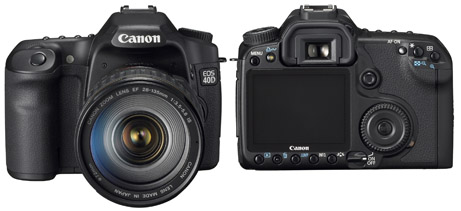
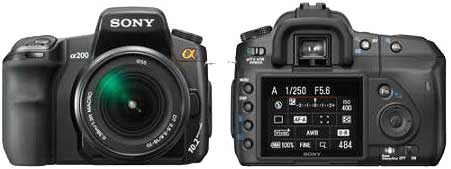
.jpg)
